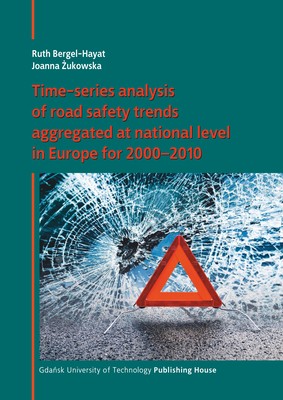
transport
Time-series analysis of road safety trends aggregated at national level in Europe for 2000–2010
Bergel-Hayat Ruth, Żukowska Joanna
ISBN/ISSN: 978-83-7348-630-0
Wydanie: 1
Rok publikacji: 2013
Stron: 84
Słowa kluczowe: trends, time-series analysis, road safety
Opis:
Książkę można pobrać bezpłatnie ze strony Pomorskiej Biblioteki Cyfrowej.
The book can be downloaded from the Pomeranian Digital Library’s website (free of charge).
profil naukowy Autorek / scientific profile – Ruth Bergel-Hayat, Joanna Żukowska
This study considers the time-series analysis methods that were developed and applied for the analysis of road safety trends at national level, in various European countries, during the period 2000–2010. The models were developed by two working groups of road safety researchers, namely, the ICTSA group (2000–2006) and the SafetyNet project (2004–2008). Over a decade, a wide range of time-series model applications were developed both at a single-country level and for comparative analysis of country groups. However, the results of various case studies are distributed across various scientific reports and papers.
This monography, written by two road safety researchers and statisticians who were directly involved in the international research activities mentioned above, provides a valuable overview and synthesis of the research findings over the last decade.
The study presents a common methodological framework underpinning the time-series analyses, by describing an underlying model of the road risk process, with risk indicators and risk factors involved, indicating data needs and limitations, and providing an effective summary of applicable statistical models. Furthermore, examples of time-series analyses carried out by selected countries (Austria, Belgium, Denmark, France, the Netherlands, Poland, Greece) are discussed, as well as the case studies of aggregative analyses of the groups of European countries. Most of the presented analyses are of an explanatory nature and therefore may be of interest for many countries, both within and outside Europe, where similar questions arise.
The authors advocate the use of autoregressive-type models and state-space models as dedicated time-series analysis techniques, thus enabling the time dependency of data to be accounted for explicitly. A primary need in exposure to risk considerations is emphasized. The possibilities of using surrogate measures of exposure (e.g. fuel sales) are demonstrated, in particular where a distinction between long-term and short-term analyses is made. It is suggested that, in the case of long-term analyses, the impacts of economic factors (e.g. unemployment rate, fuel prices) and demographic ones are to be considered, whereas for short-term analyses, the transitory factors (such as calendar characteristics or atypical weather conditions) are recommended for examination, due to their direct influence on mobility. In general, the document provides an up-to-date summary of findings of the European road safety research concerning the application of time-series analyses at a macrolevel.
As fairly concluded by the authors, a real challenge lies in implementing time-series analysis models that take into account a small number of risk factors but which could assess the impact of major safety measures.
I would recommend this monography as a useful reading for road safety researchers and statisticians who are interested in the state-of-the art of time-series analyses in road safety research.
Pobierz spis treści
Zakup publikacji:
| format | cena netto | cena brutto | dostępność |
|---|---|---|---|
| e-book | 0,00 | 0,00 | nie dostępne |